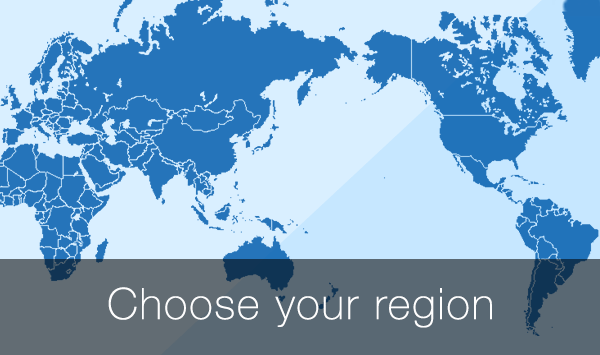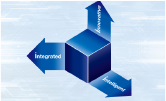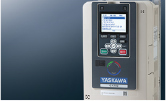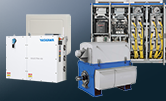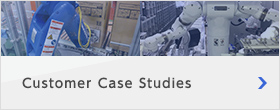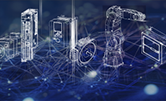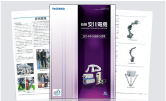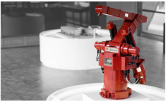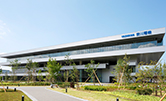Representative Director
President
Hiroshi Ogasawara
In the economic situation surrounding Yaskawa in 2018, there was a leveling off when viewed from the macro perspective due to the effects of trade friction between the US and China, the problem of the UK leaving the EU and the slowdown in smartphone related investment in China. On the other hand, factors such as the shortage of labor within Japan and the rise in the cost of labor globally led to increasing moves towards automation and efficiency improvement in production sites. As part of this, there have been demands for new solutions different to the conventional approach of simply improving the performance of equipment to raise productivity. For example, there have been demands for the more efficient operation of equipment and for the combining of the devices peripheral to the equipment to eliminate waste.
In this situation, Yaskawa has worked to further advance the core products of the company such as servos, inverters and robots, and has also promoted the concept of “i3-Mechatronics (i cube mechatronics).” This concept offers digital data solutions from the collection and visualization of the data that can be obtained from the core products and equipment to the accumulation and analysis of that data. Yaskawa has worked to strengthen the style of sales that offers solutions to the problems in the customer production sites and has promoted the development of technology to support this. In March 2018, Yaskawa established “AI Cube Inc.” as a new company to strengthen AI solution development and the company is accelerating the development of AI techniques. In December 2018, Yaskawa also began full-fledged operations at the “Yaskawa Solution Factory” at the Iruma Plant (Iruma City, Saitama Prefecture), as a plant which embodies the “i3-Mechatronics.” At this “Yaskawa Solution Factory,” not only is every process automated, the YASKAWA Cockpit software tool that forms the core of the “i3-Mechatronics” is also used to connect each process with data and to perform the steps from data collection and visualization up to accumulation and analysis. This has made it possible to demonstrate the effectiveness of the various solutions for production sites, such as for production efficiency improvement, failure prediction and preventive maintenance for facilities. From now on, Yaskawa will contribute to the creation of high added value production lines for customers by offering the new products, new techniques and digital data solutions that have been demonstrated at the “Yaskawa Solution Factory” to the customers.
The technical development in each individual division field during 2018 was as follows.
In the motion control division, the lineup of AC servo drives and machine controllers was expanded with improved data detection functions for the realization of the i3-Mechatronics concept. In the robotics division, a hand-carry type of collaborative robot was launched to make easy movement and easy placement possible, to be able to respond flexibly to the fast-changing situation in manufacturing sites. A handling robot with high environmental resistance was also launched to respond to the requirements for automation in fields such as food conveyance. In the system engineering division, machine learning was used on big data obtained by using the IoT and AI to accumulate the expertise of veteran waterworks facility operators. This machine learning was used to develop a chemical injection volume support system that calculates the predicted values from the big data. In research and development, efforts for the realization of “i3-Mechatronics” included the development of sensorless control with high speed response on servos and image processing techniques to raise the work efficiency of mobile robots.
From 2019, Yaskawa will start “Challenge25” as a new medium-term management plan with the goals of the “2025 Vision” long-term management plan. As part of this, we will aim to strengthen the “i3-Mechatronics” concept and will promote its realization. In specific terms, we will advance the merging of motion controllers and robot controllers for the merging of equipment and for integrated control within a cell. We will also aim to promote the common use of the core technologies of servos and inverters. Furthermore, the “Yaskawa Technology Center (Provisional name)” will be opened to integrate our development abilities and also to enable an integrated approach from basic research to mass production prototypes. In addition, we will work on state-of-the-art technologies by reinforcing our open innovation. Please have great expectations for our solutions as Yaskawa continues to take on the challenges of new business areas from now on.
The functions of inverters were enhanced to make it possible to coordinate with the YASKAWA Cockpit software tool, which makes it possible to collectively implement the collection, visualization, accumulation and analysis of the big data generated in the various sites of manufacturing. Also, the Drive Works EZ tool for inverter customization is used to offer a failure prediction function for each application. Efforts are being made to be able to provide solutions for the specific production sites of the users. For example, this is achieved by predicting the deterioration of the belt and bearings on belt driven machines, the deterioration of the belt and pulleys on handling machines and conveyors, and the deterioration of the rollers on horizontal conveying equipment.
Failure prediction functions
Yaskawa Europe Robotics d.o.o (Conceptual image)
Completion ceremony for third plant
at Yaskawa (China) Robotics Co., Ltd.
There is growing demand for industrial robots in Japan, Europe, the US, China and Korea, particularly in the automobile and electronic device industries. The expansion of manufacturing industry, changes in the social conditions such as the rising cost of labor and advances in robot technology have promoted the introduction of robots, both with the aim of cost reduction and also in order to secure production capacity. Due to this market environment, it is thought that the demand for robots will continue to increase.
Yaskawa will strengthen its proposal of user solutions under the concept of “i3-Mechatronics (i cube mechatronics),” the digital data solution put forward by the company. In order to respond to the demand in each region around the world, Yaskawa is promoting initiatives to strengthen development and production systems and is also promoting alliances with local companies.
In Europe, preparations are continuing for the start of mass production at Yaskawa Europe Robotics d.o.o, which was established in Slovenia in order to raise the competitiveness of the company locally by responding in detail to the needs of local customers.
In China, the Yaskawa subsidiary Yaskawa Electric (China) Co., Ltd. began a capital tie-up with the Chinese company Anhui Ruixiang Industrial Co., Ltd. for the purpose of the manufacturing and sales of automated production equipment for automobiles. Anhui Ruixiang Industrial is a system integrator that has strengths in its production control and sales routes for automobile manufacturers in China. The tie-up collaboration will make it possible to make new proposals to meet the increasingly diverse needs of customers in the Chinese market.
Furthermore, the completion of the third plant at Yaskawa (China) Robotics Co., Ltd. in Changzhou City, Jiangsu, China has expanded the production capacity to 1,500 units/month to respond to the demand in the Chinese market, which is predicted to continue growing from now on.
The new products that were exhibited at the International Robot Exhibition 2017 have been gradually launched on the market.
For welding application robots, the medium and large-sized robots with a hollow structure upper arm part such as the MOTOMAN-SP225H were launched. This has made it possible to contribute to the construction of high added value production lines in the automobile industry. The MOTOMAN-HC10DT Hand-carry Type collaborative robot that can work in the same space as humans was also launched on the market. The combination of the flexibility that is one of the merits of the MOTOMAN-HC10DT and the use of a movable truck makes it possible to respond flexibly to different work tasks in production that has process variation. Furthermore, a smart pendant compatible with the collaborative robot was launched to realize easy operation even if the user is new to or relatively unfamiliar with robot operation.
MOTOMAN-HC10DT Hand-carry Type (left) and Smart pendant (right)
The YASKAWA Cockpit product was launched as a software tool for the construction of digital solutions. This makes it possible to collectively implement the collection, visualization, accumulation and analysis of the big data generated in the various sites of manufacturing, particularly that collected via products such as servos and robots.
i3-Mechatronics (Conceptual image of coordination with YASKAWA Cockpit)
The profits of each iron and steel company in Japan have recovered remarkably. The situation of demand is also good and the companies are in a state of full-production. Furthermore, active capital investment in excess of the previous fiscal year has been planned for three consecutive years and there has been an increase in the production of advanced materials such as electromagnetic steel plates and super high tension material for automobiles. At the same time, there has also been a promotion of stronger competitiveness by reducing costs and a promotion of stable production with facility refreshment. On the other hand, there are concerns about the effects that a shortage of labor will have on operations. As one possible solution to this, there is increasing interest in automation separate from conventional labor saving investment.
In response to these changes in the market, Yaskawa has worked on the development and introduction of automation systems that achieve shorter operator work time and higher operation efficiency, and robot application systems that achieve labor saving.
The sewage and waterworks related budget for fiscal 2018 was around the same as in fiscal 2017 and the volume of electrical installation ordering was also the same as in fiscal 2017. However, the reduction in the number of employees engaged in the work and their increasing age has meant that the passing on of expertise on sewerage operation is becoming an issue.
In response to this market situation, Yaskawa has worked on an operation support system for the injection of chemicals that achieves the passing on of the expertise of veteran employees and support for operators. The company also worked on a cloud monitoring system for water purification plants that achieves a wider area of facility monitoring, the improvement of control quality and business continuity measures at the time of disasters.
Research related to support techniques for sewerage operation control
Chemical injection volume support system
Generator for wind power generation for a certain company
(8.6-10 MW)
In the wind power generation market, there has been an expansion of the introduction of offshore wind turbines in Europe in particular, and there has also been an acceleration and expansion of offshore wind power planning in the Asian market.
In the solar power generation market, there has continued to be short-term market stagnation in the US due to the application of safeguard tariffs on photocells. However, within Japan, there have been strong trends towards the early starting of the operation of projects already approved and towards the expansion of the use of solar power for home consumption.
In response to these changes in the market, Yaskawa has reorganized each business base for environmental energy to the locations of demand (Europe, US) to accelerate global expansion.
Yaskawa booth at World Robot Expo 2018
Remote controller assembly line
The World Robot Summit (October 17-21, 2018) was an international robot competition and exhibition hosted by the Ministry of Economy, Trade and Industry and NEDO (New Energy and Industrial Technology Development Organization). It was held as a preliminary meeting in preparation for the main event in 2020 and was visited by more than 40,000 people. Yaskawa exhibited the remote controller assembly line at the World Robot Expo, where companies, organizations and local authorities exhibited their latest robot technology.
This equipment promotes the merits of i3-Mechatronics (i cube mechatronics) such as cooperation between equipment, improved line integration and data visualization. Ten of the MotoMINI small-sized robots execute assembly and disassembly work at high speed in synchronization with the motion of the continually operating conveying equipment. The conveyor synchronization function makes it possible for the assembly work to follow the conveyor even if there is variation in the speed. Remote controllers were adopted as the workpiece because the 3C industry market was imagined. A monitor screen was placed on the upper part of the equipment and displayed the data obtained from the equipment, which attracted a lot of attention.
Yaskawa booth at Robot Industry Matching Fair
in Kitakyushu 2018
Data collection and analysis module
3-axis robot demonstration equipment
The data collection and analysis module was displayed as a reference exhibit at the Robot Industry Matching Fair in Kitakyushu 2018 (June 13-15, 2018, West Japan General Exhibition Center).
This module collects the data flowing in the MECHATROLINK-Ⅲ motion field network with a maximum speed of a 125 µs cycle. It accumulates that data inside the module and analyzes the data gathered in real time inside the module. It can also be retrofitted to existing equipment for use. In the exhibit, the module was connected to demonstration equipment with a 3-axis robot, to introduce the fact that it can perform real time detection of abnormality on the equipment by analyzing the data collected. During the period of the exhibition, it was possible to obtain opinions from many visitors that will be useful for development from now on.
Kyushu Region Invention Awards
(1) The “AC motor control equipment (Patented)” was awarded the Kyushu Industrial Technology Center Chairman’s Award in recognition of its contribution to the spread and promotion of inverter devices. This invention is used for permanent magnet synchronous motors, which it is hoped will spread further, particularly in industrial applications. The invention automatically adjusts the control parameters that are difficult to adjust, so it contributes to a shortening of setup time and improvement of control performance. This expands the scope of application of permanent magnet synchronous motors, so it can contribute to the further spread of the motors and energy saving.
(2) The “Resonant frequency detection equipment for motor control equipment (Patented)” was awarded the Invention Encouragement Prize. The inclusion of original resonant frequency detection equipment inside a servo driver makes it possible to understand the resonant frequency when a servo motor is connected to a machine and operated, so it becomes easy to make adjustments for the optimization of the servo driver for those characteristics.
The Σ-7 Series and various other servo products are equipped with this function under the name “EasyFFT.” It contributes to productivity enhancement on industrial machines and contributes to the improvement of quality on the products produced.
A lot of polishing work is performed manually, but it is becoming increasingly difficult to secure the necessary personnel. There are also increasing requirements for polishing work to be robotized in order to reduce variation in quality resulting from different levels of skill. However, teaching a robot the polishing operation is difficult and takes a long time. There are some manufacturers that are promoting robotization of such tasks, however the time required for the teaching makes it is difficult to support a large number of different workpieces. In order to solve this problem, Yaskawa has developed a simple teaching function that can replace the programming pendant and supports the robotization of work such as polishing. The aim of this is to contribute to a shortening of the system startup time required when supporting a large number of different workpieces. Yaskawa has recently developed a demonstration teaching function that can secure work quality equivalent to that of human workers. The function makes it possible for users who are unfamiliar with industrial robots to perform the teaching process easily and also quickly, without using a programming pendant. This function is an intuitive teaching device that can obtain the workpiece posture and necessary forces applied by the worker and convert it into robot action.
This paper describes the details of the demonstration teaching function and the results of verification on polishing work.
To further improve the productivity of industrial robots, it becomes important for the robot to perform the operation that is appropriate for the sensing data during various assembly work such as fitting, for which the sensing data is the contact between parts and their position and posture state. The MOTOMAN industrial robot from Yaskawa can perform fitting work when the optional MotoFit 6-axis force sensing control function is used. However, when MotoFit is used, a long time is required for the adjustment of the parameters to produce highly efficient work action for the target workpieces. There is also poor work efficiency when there is large misalignment between the hole position and posture and the axis. Yaskawa has therefore developed an action generating technique using machine learning to be used for column fitting. In this technique, the robot collects the data independently and generates a model to decide the appropriate direction of action for the misalignment. This makes it possible to expect that fitting work will be obtained that has robustness against position and posture misalignment. The fitting work obtained can also be fitting work with greater performance than MotoFit fitting work.
This paper describes the outline of the skill acquisition technique for column fitting that was developed as the application of AI techniques to assembly work. The evaluation results and prospects for the technique from now on are also described.
 Region
Region



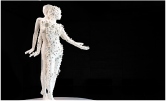 Principles & vision
Principles & vision
 Procurement
Procurement
 Sustainability for the Yaskawa Group
Sustainability for the Yaskawa Group
 Customer satisfaction
Customer satisfaction
 Supply chain
Supply chain
 Social contribution
Social contribution
 Compliance & risk management
Compliance & risk management


